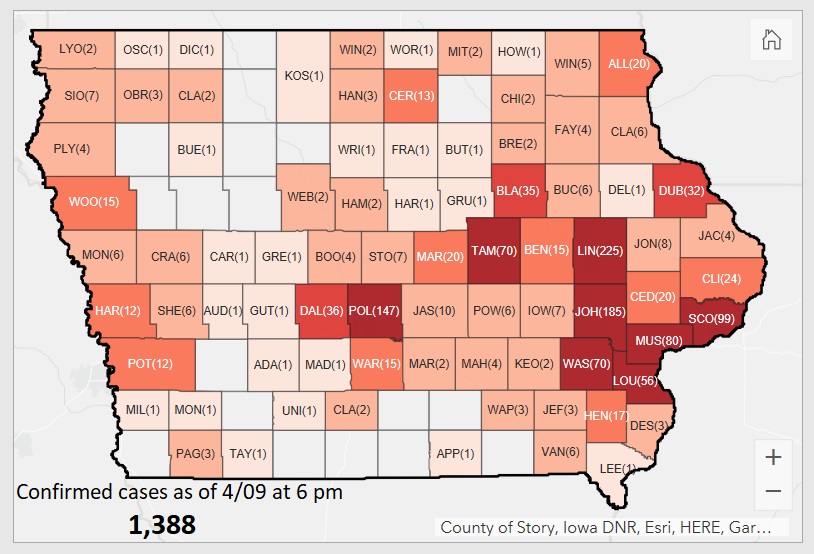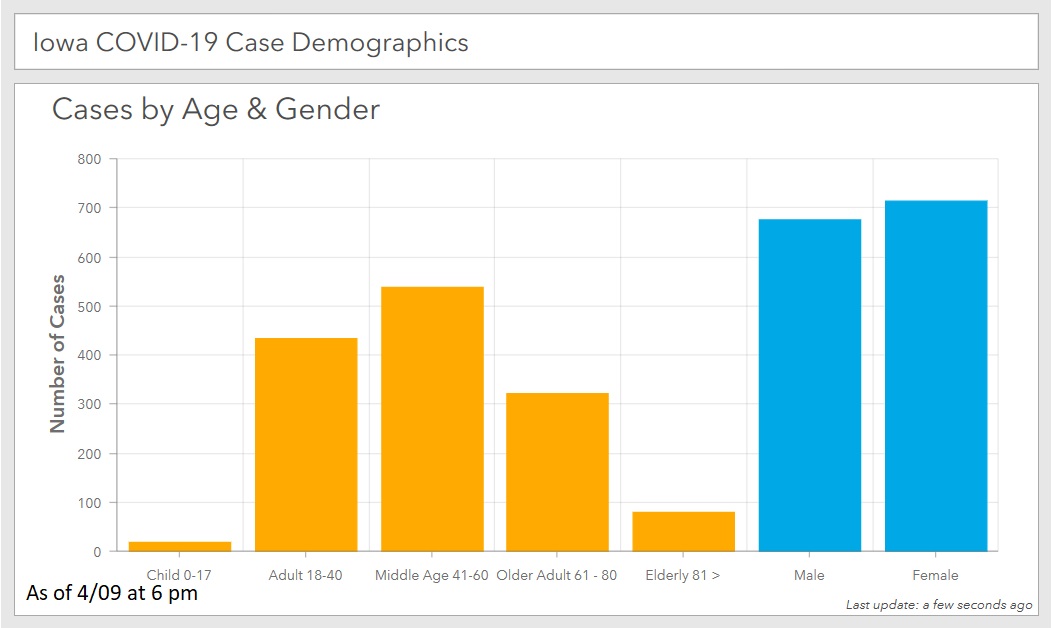The news on the COVID-19 front in Iowa was less grim Thursday (April 9), with a hint that mitigation efforts are working, but Iowa, but the battle isn’t over. Iowa Department of Public Health deputy director Sarah Riesetter made it clear at the Friday press briefing that not only is the battle not over, but the healthcare team fighting the battle is running out of gear.
The IDPH on Friday issued a “shortage order” with new guidance for the use of personal protective equipment (PPE).
The PPE shortage order applies to all healthcare providers and facilities and all who use PPE when treating patients or residents of a facility. The order requires providers to decrease demand for PPE by minimizing patient contact when possible and maximizing the way barriers (masks and shields) and ventilation systems are used.
The ban on elective medical and dental procedures is repeated in the order and telehealth is to be used whenever possible. Patients seeking care are now required to cover their nose and mouth with something other than a surgical face mask.
If those steps are used and the need for PPE still is greater than the supply, providers must use face masks that may be beyond their expiration date; not change their masks or respirators for each patient encounter; use washable gowns and reusable eye protection; and decrease the length of hospital stay for COVID-19 patients if they’re medically stable.
The final step if need continues to outpace supply is to implement “crisis capacity standards.” Those would include reusing PPE; prioritizing face masks for essential activities that may involve direct infectious contacts; and considering using homemade masks in conjunction with face shields.
The order provides immunity for providers that need to implement the steps named.
Riesetter said IDPH understands the order may be “unsettling,” “but due to the global shortage of PPE supply, we’ve determined that now is the time to take this action.”
Planning for further shortages of PPE is one reason for the order. Another reason, according to Riesetter, is to raise awareness across the state, as some areas are more seeing more cases than others. The order intends to get healthcare providers working together to maximize resources “so we can continue to take care of all Iowans.”
The IDPH website includes more information about making homemade face masks and wearing face covers when in public.

Gov Kim Reynolds said a shortage of PPE “has been a concern all along,” and that an important reason for the mitigation effort has been to protect healthcare workers and first responders. ‘We want to do everything we can to provide them the PPE that they need, but in the event that we can’t, these are some of the steps we need to take,” she said.
“We are concerned about out healthcare providers. They’re on the front line. They’re doing this every day,” Riesetter said. “We’re doing everything we can to procure additional PPE….and we’ll continue to distribute that to the areas of highest need.”
In her opening comments, Reynolds discussed food insecurity as an unintended consequence of the mitigation efforts. She said there were 354,000 Iowans facing food insecurity before the COVID-19 pandemic forced the closing of businesses and loss of jobs. In March, use of Iowa food pantries increased 65 percent compared to March 2019, but donations decreased.
Reynolds has appointed a Feeding Iowans Task Force headed by Lt Gov Adam Gregg to raise awareness of hunger-related issues; identifying potential gaps in the system; connecting resources to make sure Iowans have food on their tables; and making sure Iowans know where to get help.
Persons from the Iowa Food Bank, the governor’s “team,” and representatives of the Iowa departments of Agriculture and Land Stewardship, Homeland Security, Emergency Management, Public Health, Human Services, Education and Aging, and Volunteer Iowa.
Some of the funds in the federal CARES Act will go to food insecurity issues.
According to Reynolds, 40 percent of the volunteers at Iowa food pantries are older Iowans who should be staying home. Volunteer Iowa has launched a volunteer portal to help Iowans fill in gaps in volunteer staff. “If you’re healthy, low risk, and do not live with anyone who is ill or high risk, please consider volunteering,” Reynolds said. Visit coronavirus.ia.gov for more information.
She also acknowledged the Iowa Pork Producers, Iowa Beef Council, AE Dairy, Tyson Foods, Iowa Egg Producers, Smithfield Foods, and Lynch Livestock Companies/Lynch Family Foundation/Premium Iowa Pork for large donations to Iowa food pantries and Corteva Agriscience, the Iowa Farm Bureau Foundation, and MidAmerica Energy for large cash donations to support food relief in Iowa.
Reynolds provided updated information about RMCC Region 1, which includes Greene County.
Numbers from IDPH for the 24 hours ending April 9 at 6 pm showed 118 new cases of COVID-19 for a total of 1,388 cases in Iowa.* There have been a total of 14,565 negative tests reported by the State Hygienic Lab and other labs.
Two additional deaths were reported – a Linn County resident age 61-80 and a Linn County resident older than 81.
According to IDPH, the locations and age ranges of the 118 newly-identified patients include:
• Allamakee County, 1 middle-age adult (41-60)
• Black Hawk County, 6 adults (18-40 years), 7 middle-age adults (41-60 years), 1 older adult (61-80 years)
• Cedar County, 1 adult (18-40 years)
• Clarke County, 1 middle-age adult (41-60 years)
• Clayton County, 1 adult (18-40 years)
• Clinton County, 2 middle-age adults (41-60 years), 1 older adult (61-80 years)
• Dubuque County, 1 middle-age adult (41-60 years)
• Fayette County, 1 middle-age adult (41-60 years)
• Harrison County, 1 older adult (61-80 years)
• Henry County, 1 adult (18-40 years), 1 older adult (61-80 years)
• Jasper County, 1 adult (18-40 years)
• Johnson County, 1 child (0-17 years), 5 adults (18-40 years), 6 middle-age adults (41-60 years), 2 older adults (61-80 years)
• Linn County, 3 adults (18-40 years), 4 middle-age adults (41-60 years), 2 older adults (61-80 years), 1 elderly adult (81+)
• Louisa County, 5 adults (18-40 years), 6 middle-age adults (41-60 years), 3 older adults (61-80 years)
• Marshall County, 2 adults (41-60 years)
• Muscatine County, 2 adults (18-40 years), 8 middle-age adults (41-60 years), 1 older adult (61-80 years)
• Osceola County, 1 middle-age adult (41-60 years)
• Polk County, 6 adults (18-40 years), 1 older adult (61-80 years)
• Pottawattamie County, 1 middle-age adult (41-60 years)
• Scott County, 3 adults (18-40 years), 6 middle-age adults (41-60 years), 1 older adult (61-80 years, 1 elderly adult (81+)
• Tama County, 4 adults (18-40 years), 3 middle-age adults (41-60 years)
• Union County, 1 older adult (61-80 years)
• Wapello County, 1 adult (18-40 years)
• Warren County, 1 adult (18-40 years), 1 middle-age adult (41-60 years)
• Washington County, 2 adults (18-40 years), 2 middle-age adults (41-60 years), 1 older adult (61-80 years)
• Winnebago County, 1 adult (18-40 years)
• Woodbury County, 3 middle-age adults (41-60 years)
*The total number of positive COVID tests represents 44-thousandths of 1 percent (0.044) of the total population of Iowa.

